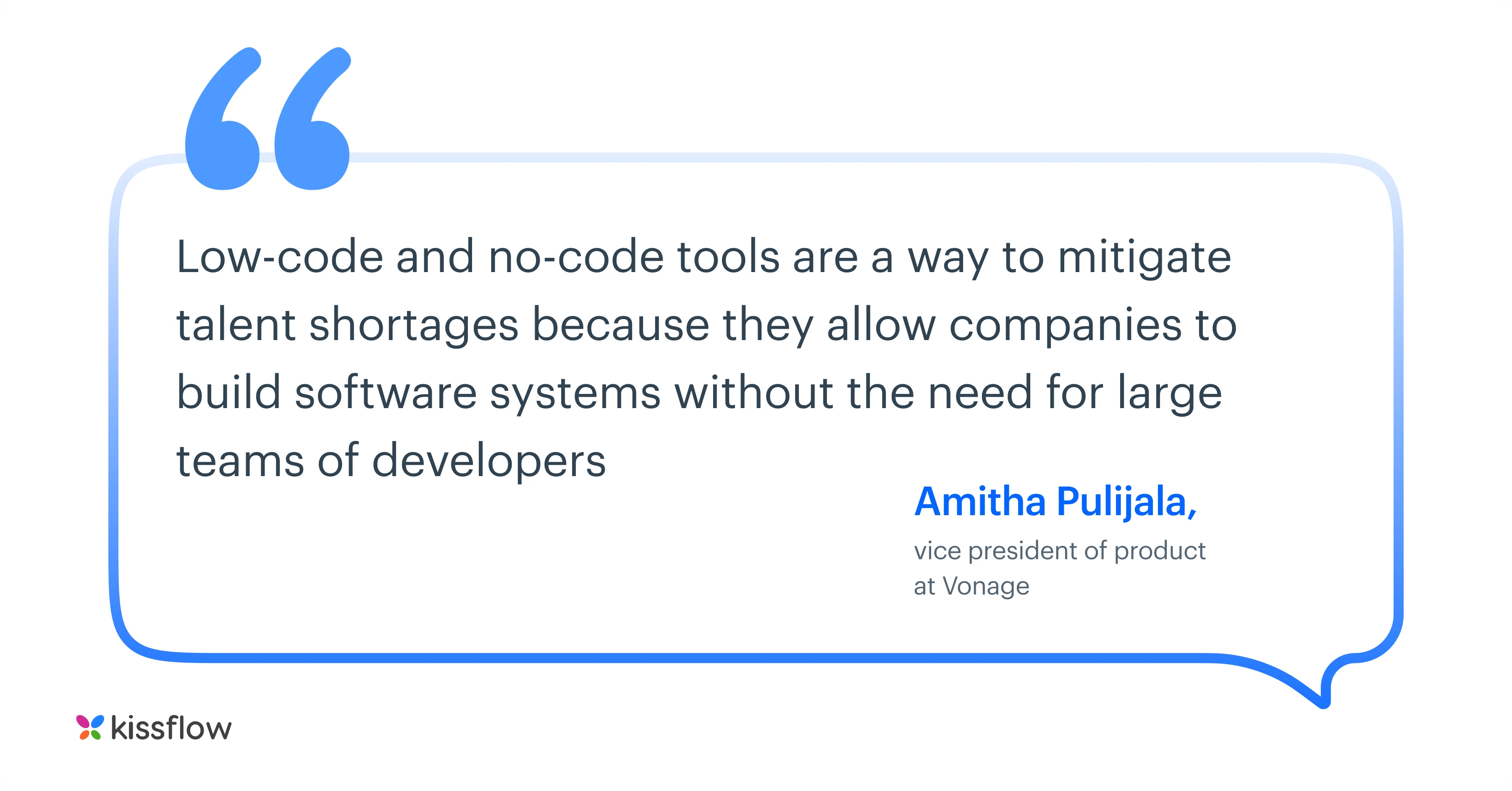Digital transformation has become a crucial initiative for enterprises across all industries for maintaining a competitive advantage. But most CIOs are struggling to reach the finish line of their digital transformation initiatives as the demand of business applications is increasing beyond what IT can deliver.
To overcome this clear talent shortage, enterprises are readily adopting low-code platforms which reduce the barrier to entry in application development.
According to Gartner, the use of low-code and no-code, which was only up by 25% in 2020, will almost triple by 2025.
What is low-code?
Low-code takes a visual approach to software development by allowing users to build applications and processes with little to no coding. Instead of using programming languages, users leverage visual drag-and-drop capabilities to quickly build business apps.
By uncomplicating the app development process, low-code platforms allow even business users to build apps on their own, while still maintaining IT governance and avoiding shadow IT.
History Of Low-Code :
Low-code technology has its roots in the early 2000s, with the rise of rapid application development (RAD) platforms. These platforms aimed to provide a more visual, drag-and-drop approach to application development, allowing users to build applications faster and with less coding.
By the mid-2010s, low-code had become a mainstream technology, embraced by organizations of all sizes for its ability to speed up development and reduce costs.
To say that low-code development platforms have made an impact in the world of programming would be a monumental understatement; they’ve revolutionized the way companies, and developers work.
Read this article on Power Automate to see how modern automation tools are building on the legacy of low-code platforms.
Low-code application development platforms have made programming easier and more efficient than ever before. Instead of typing out hundreds of thousands of lines of code to create an application, these platforms have made it simple with visual workflows, drag-and-drop features, and more.
In 2014, Forrester coined the term “Low-code” to classify development platforms that focused on development simplicity and ease of use. These platforms allowed developers and users of all skill levels to code applications, without having the outright need to know coding. And the trend caught on like wildfire.
Forrester states that the term “low-code development” was first used in a 2011 report on new productivity platforms for building custom apps. Bubble was the first no-code platform launched in 2012 that enabled visual programming by replacing traditional coding.
But where did the low-code trend start? That’s a question worth exploring to understand why low-code development platforms continue to dominate the market.
The Evolution of Programming Languages
The term “programming languages” evokes thoughts of C, C++, Java, SQL, and other computer languages with complicated syntaxes and endless lines of code.
But this isn’t where programming languages started out. That particular origin story begins a lot earlier.
In the 1940s, the first electronic computers came into existence. But there was a problem. Early level assembly languages were horribly complicated. Programming with them was like trying to carve “David” with a toothpick.
There had to be a better way.
Enter FORTRAN
A breakthrough came with the invention of FORTRAN by computer giant, IBM. The fact that it wasn’t just limited to being a test subject but was actually functional, made it revolutionary and incredibly popular. Another thing that made FORTRAN so revolutionary was that it was great for high-performance computing. A lot of the world’s modern supercomputers still use it, and there are benchmark programs made out of FORTRAN that push these behemoths to see how far they can go.
But FORTRAN still had a problem. It was mostly useful for scientific and numeric computing. Also, it wasn’t as intuitive as people needed it to be. In addition to all of this, it was limited in what it could do.
And that’s where COBOL came in to pick up the slack.
But Why The Internet?
The Internet is a huge platform where different systems running different platforms all have to work well with each other. Because of that, programming languages had to evolve to support that need.
Web applications became more popular, browsers became more complex, we started using smaller and simpler scripts for simpler tasks, and instead of having a complete programming language, there was a focus on function. If a language could do one thing, and do it well, it was useful. Otherwise, it was thrown to the waste pile. Applications needed to be developed at a faster pace, and languages had to be easy enough to support that.
This is the time when concepts like rapid application development and low-code actually started. Modern languages were focused on helping developers speed up the development process, not spend hours searching for that one semicolon they missed.
Great examples of this are PHP, JavaScript, and Python.
Forrester, Gartner, and the Low-code Love Affair
Forrester coined the term, and Gartner helped them introduce it to the masses. But they both have very similar definitions of what low-code is.
Forrester says:
“Low-code platforms enable rapid delivery of business applications with a minimum of hand-coding and minimal upfront investment in setup, training, and deployment”
Gartner has a similar definition:
“Low-code development both describe platforms that abstract away from code and offer an integrated set of tools to accelerate app delivery”
But what does “abstract away from code”, “an integrated set of tools to accelerate app delivery”, and “rapid delivery of business applications” mean when you strip away the tech speak?

Why Low-code Platforms are Inevitable
At the end of the day, business users care about a very simple list of things. They want to spend less money, improve productivity, waste less time, and make more money.
And that’s why low-code platforms succeeding is an inevitability. They provide a way to do all of that.
You don’t need to invest in expensive training programs for your employees. You can have them build apps faster, with less training. And at the end of the day, all of this makes your business more revenue.
But keep in mind that low-code doesn’t mean there’s no code involved at all. It just makes it a lot more easier for your existing developers to create applications without spending arduous hours on coding. A lot of the development becomes visual, using modules and templates that can be freely sourced from the Internet.
As low-code platforms evolved over time, they’ve often been compared with no-code solutions—this low-code vs no-code comparison outlines how the two differ in approach, complexity, and use cases.
Conclusion
Low-code isn’t the future. It’s here. It’s now. It’s already happening, and if you’re not on the train yet, it’s high time you got on it.
Low-code development platforms aren’t just another logical step in the evolution of programming languages and development platforms. These platforms are going to change how business is done.
But right now, if you haven’t considered a low-code development platform to improve your business productivity, it’s time you take a look. Start off with something simple, like Kissflow. As a low-code platform, it can create apps to automate your workflows, manage, and track employee productivity, all without having to write a line of code. If you aren’t convinced, take it for a spin with a free trial and see if it’s right for your organization. Get started with the Kissflow Platform and learn how to leverage its features to drive better results





![What is the Future of Low-code Application development? [Updated 2021]](https://kissflow.com/hs-fs/hubfs/Low-code-application-development-FEATURE-1.png?width=352&name=Low-code-application-development-FEATURE-1.png)









